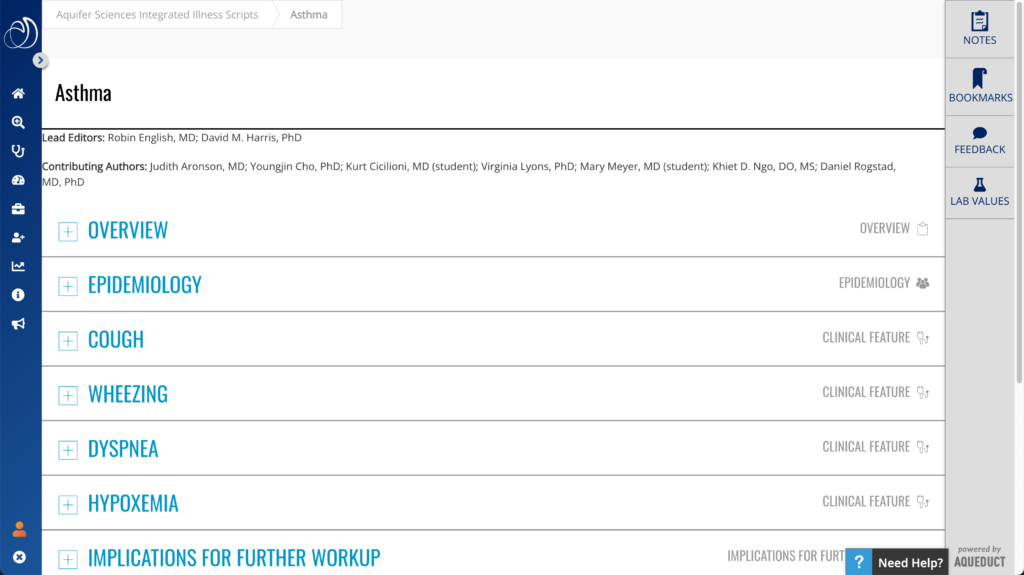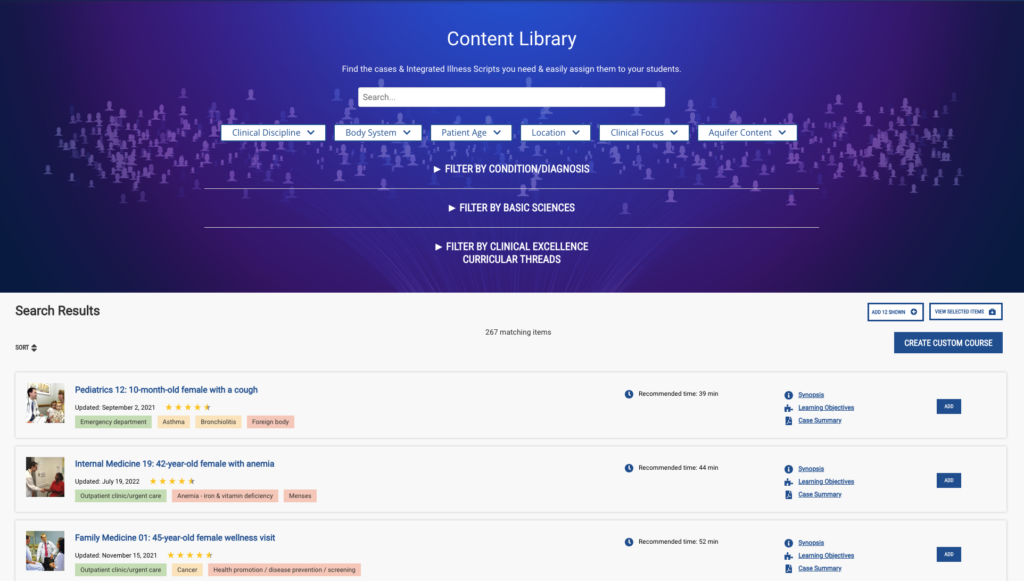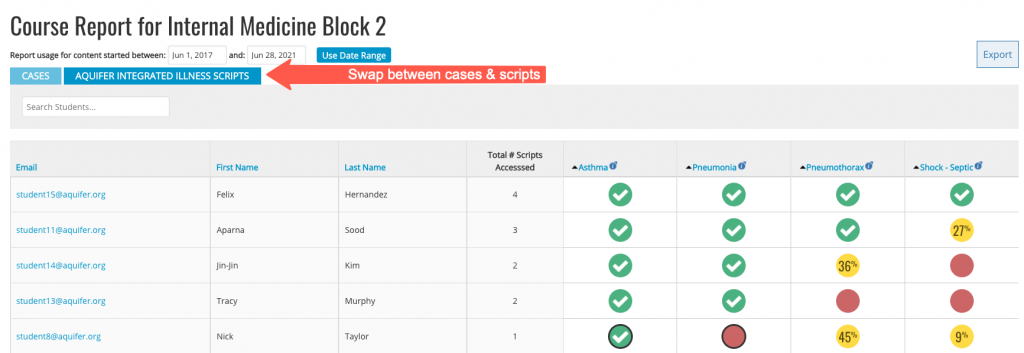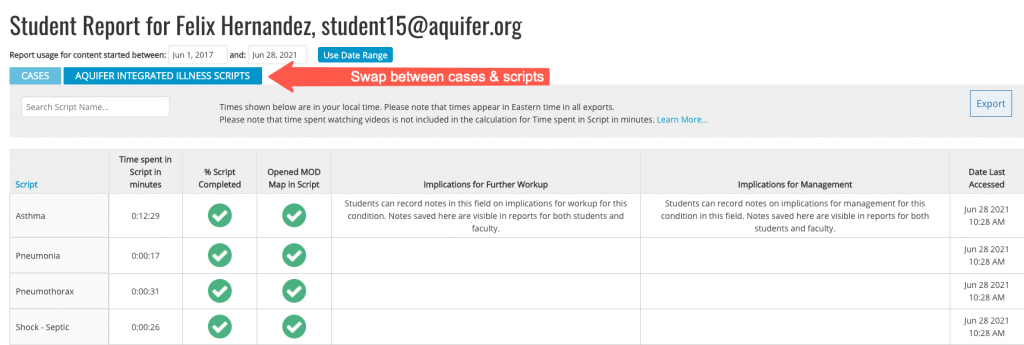Welcome to Aquifer’s Integrated Illness Scripts! We hope you enjoy our latest teaching and learning tool, which integrates basic science and clinical learning.
Integrated Illness Scripts are an innovative teaching and learning tool specifically designed to promote cognitive integration and provide a framework for learners to link basic science and clinical knowledge. Building on the traditional illness script format, Integrated Illness Scripts embed basic science core concepts and causal mechanisms within each clinical feature.
If you are unfamiliar with Integrated Illness Scripts, we have deep resources to get you up to speed.
Using Integrated Illness Scripts
Incorporating Integrated Illness Scripts into your course or curriculum is a great way to reinforce the linkage between basic science and clinical concepts in your students’ minds. Designed for use in both the classroom and the clinic, scripts can support all levels of students and faculty.
- In a basic science course, scripts deliver clinical context that helps make content stick.
- In clinic, scripts remind students of basic science concepts and the ‘why’ behind conditions to help inform better, safer clinical decisions.
- For faculty, scripts provide easy-to-use tools with nationally-developed content, enabling comprehensive teaching spanning disciplines.
Learn more about how to use Integrated Illness Scripts.
Accessing Integrated Illness Scripts
Integrated Illness Scripts are accessible from your Aquifer account in the searchable Content Library. The Content Library can be accessed on your home screen.

The Illness Scripts are always shaded blue, so you can distinguish them from our cases.

Script synopses give you a quick link to a summary and a view of the Mechanism of Disease Map for each condition.

Inside Integrated Illness Scripts
Each Integrated Illness Script includes a brief Overview, followed by the Epidemiology section. References with links are included throughout. Next, you will find the most common Clinical Features of the disease—up to 6 for each condition—with a causal explanation focusing on the ‘why’. Each Clinical Feature is linked to the relevant basic science core concepts.

In the Implications for Further Workup and Management sections, students can enter responses on key implications for consideration. Responses to these sections are visible in reports for both students and faculty. Mechanism of Disease Maps are a visual summary of the learning on each condition, tracing the path from the original insult (or disease trigger) through the causal mechanisms to the resulting clinical features seen at presentation, all tied to the basic science core concepts.
Learn more about the anatomy of an Integrated Illness Script.
Using Aquifer’s improved notes and bookmarking features, located in the toolbar on the right side of your screen, students can take notes, bookmark sections of a script, and reference lab values.

We encourage all users—including faculty and staff—to use the feedback section to share thoughts, comments, and suggestions about this new resource.

Finding Content & Creating Custom Courses
Using the Searchable Content Library
You can use the searchable Content Library to quickly find the Integrated Illness Scripts you want to use—and to add scripts to a new custom course. In your content library, Integrated Illness Scripts behave just like Aquifer’s cases.

It’s easy to find the Integrated Illness Scripts you need to add to a course on a relevant system or discipline for easy reference and deeper learning, to support students in need of remediation, or to combine with cases for a focused didactic session or activity.
Integrated Illness Scripts are mapped to the following filters:
-
Clinical Discipline
-
Body System
-
Patient Age
-
Location
-
Clinical Focus
-
Aquifer Content
You can refine your search by filtering by Condition/Diagnoses, Basic Sciences, and Clinical Excellence Curricular Threads.
Once you’ve found the content you need, click “Add” next to each case or script and create a new custom course from your selection.

Adding Scripts to Existing Custom Courses
If you have a custom course that is already in progress, or you have a set of cases you reuse, you can add Integrated Illness Scripts to your existing custom courses at any time to enhance your students’ learning and provide valuable reference guides.

Tracking Student Progress
Your students’ progress in Integrated Illness Scripts is tracked in Aquifer’s reporting, similar to the way case work is tracked.
If your custom course includes both cases and scripts, you’ll notice that your Course Report now includes tabs for each. Your export from this view will include work completed in both cases and scripts.

In the individual Student and Script Reports, more details are included, such as time spent viewing a script, whether the Mechanism of Disease Map was viewed, and any notes that students added in the implications for further work-up and management sections.

Teaching Guides & More
To find out how to use Integrated Illness Scripts in your course or curriculum, be sure to review the Aquifer Integrated Illness Scripts Educator Guide and ready-made Integrated Learning Sessions available in the Educator Resources section on your Aquifer account Courses page.
You’ll also find best practice integration examples in our blogs and webinar recordings, and many more resources on the Using Integrated Illness Scripts page.
